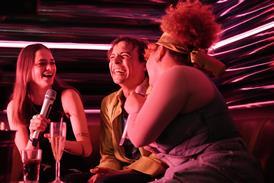Dir/scr: Emanuele Crialese. Fr-It. 2006. 118mins.
A moving but unsentimental film of mythic resonance aboutthe early years of mass Italian immigration to the United States, The Golden Door consecrates Sicilian directorEmanuele Crialese as a film-makerof global significance after his promising earlier features, Once We Were Strangers (1997) and Respiro (2002). Turningthe sea passage from the old to the new world into a symbolic odyssey was a riskymove: but Crialese pulls off the trick in style, rarelyletting the parable submerge the drama.
The Golden Door has enough confidence and cinematic gloss to overcome some of the diffidenceof Italian audiences towards home-produced drama. International prospects look rosytoo; many of those who applauded after the film's press screening at
American audiences - thefilm plays
Crialese splits the film into three acts which are as much symbolicas dramatic. A couple of Dantean visual references throwout the suggestion that these three parts of the immigrants' journey may be intendedas hell, purgatory and heaven.
In reality this is a false trail,as the director is more interested in how the illiterate Sicilian peasant familyat the heart of the story cope with the abrupt fast-forward that they are forcedto make between a "primitive" rural society and an "advanced" industrial one. Andthe
The opening scenes present analmost primeval picture of life in the Madonie mountains of northern
The answer - so it seems to Salvatore- comes in the form of a series of postcards (based on authentic historical models)showing
That the sea voyage which Salvatoreeventually embarks on with five other members of his family is intended, at leastin part, as an allegorical crossing, is brought home by a high slanting shot ofthe ship's departure: at first, the crowd on deck and the crowd on the quay areone unified mass, but as the ship pulls away a gulf opens up between them. The steeragepassengers are herded into dark communal dormitories, one for women and one formen. They occasionally emerge into the light - though it's an uneasy, fog-boundlight, in which the ship's dark gaping funnel mouths loom like portals to the underworld.
Charlotte Gainsbourg plays Lucy, an English woman whose backstory is never fully explained: all we now is that she's desperate to get to
Veteran Italian actress AuroraQuattrocchi gives one of the film's strongest performancesas Donna Fortunata, a character who seems at first torepresent the pagan backwardness of the old world (early on, we see her performinga sort of fake exorcism involving a snake) but gradually grows in authority to becomethe film's moral anchor.
Amato conveys Salvatore's waryinnocence, his emotional reserve contrasting with the more modern lack of inhibitionof Lucy, the woman whose initial view of the rough peasant as merely a ticket toAmerica (single women were not allowed to make the assisted passage) shifts towardsrespect and affection.
Gainsbourg's ethereal quality is exploited well here: it would havebeen easy to coarsen her character by giving her too much of a back story, or buildingon the hint that she is not above selling her time (if not her body) to wealthymen. The French actress plays her convincingly as a delicate, melancholic soul whoseems to float somewhere above the mess that she seems to have got herself into.
Among the technical contributions,Agnes Godard's sensitive scope photography stands out:like the script itself, is goes for reticence over flashy display, stressing thearchetypal qualities of the journey from the old world to the new.
Production companies/backers
Memento Films Production
Rai Cinema
Titti Films
Respiro
ARTE
Canal Plus
International sales
Wild Bunch
Italain distribution
01 Distribuzione
Executive producers
Bernard Bouix
Tommaso Calevi.
Producers
Alexandre Mallet-Guy
Fabrizio Mosca
Emanuele Crialese
Cinematography
Agnes Godard
Production design
Carlos Conti
Editor
Marilyne Monthieux
Music
Antonio Castrignano
Charlotte Gainsbourg
Vincenzo Amato
Aurora Quattrocchi
Francesco Casisa
Filippo Pucillo

















No comments yet